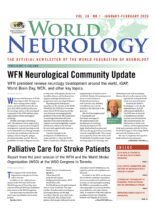Toward a pharmacology and toxicology of words.
Placebo and recently the term nocebo are often used in situations where uncertain effects, possibly the effect of the mind works, and have been often disregarded as scientifical activities. All of us working with patients are implicitly using the concept of placebo, and sometimes the negative prediction, the nocebo.
As members of the health profession, we are part of placebo effect, and investigations have shown that also in regular approved and effective drugs a percentage of placebo effect can be calculated. The awareness of these important effects are important. The perception of placebo effect can in several instances be blocked or denied by cultural practices, and for neurology, it is important to spread and enhance the global perception.
Prof. Benedetti has worked on the placebo effect over many years and has given the placebo effect a rational and scientific background.
We are pleased that Prof. Benedetti has accepted our invitation and given a short summary of his important work.
– Wolfgang Grisold

Fabrizio Benedetti, MD, MAE
Fabrizio Benedetti, MD, MAE
Modern medicine and neurology have progressed in parallel with the advancement of biochemistry, anatomy, and physiology. By using the tools of modern medicine and neurology, today the physician and the neurologist can treat and prevent a number of diseases through pharmacology, genetics, and physical interventions, including surgery. In addition to this materia medica, the patient’s mind, cognitions and emotions play a central part as well in any therapeutic outcome. Placebo effects are at the very heart of these issues and, maybe paradoxically, they can be approached by using the same biochemical, cellular, and physiological tools of the materia medica, which represents an epochal transition from general concepts such as suggestibility and power of mind to a true physiology and biology.
Placebo effects remind us of the old tenet that patients must be both cured and cared for, and they teach us that these complex issues can today be investigated by using a physiological and neuroscientific approach. The intricate psychological factors involved can be approached through biochemistry, anatomy, and physiology, thus eliminating the old dichotomy between biology and psychology. This is both a biomedical and a philosophical enterprise that is changing the way we approach and interpret medicine, neurology, and human biology.
In the first case, curing the disease only is not sufficient, and care of the patient is of tantamount importance. In the second case, the philosophical debate about the mind-body interaction can find some important answers.
Although a terminological confusion still persists and the terms placebo effect and response are often used interchangeably, placebo effect could be considered different from placebo response. In the same way as the drug response is the global response to drug administration, so the placebo response is the whole response to placebo administration, including natural history of disease, regression to the mean, and such like.
Conversely, in the same way as the drug effect is the specific pharmacodynamic effect of a drug, so the placebo effect is the specific effect of placebo administration, that is, the real psychobiological phenomenon deriving from the psychosocial context around the patient. What neuroscientists have learned over the past few years is placebos are not inert substances. Instead, they are constituted of different words and therapeutic rituals as well as of different symbolic elements which, in turn, can influence the patient’s brain, thus they are amenable to classic neuroscientific investigation. Therefore, overall, a placebo is the whole ritual of the therapeutic act. Neuroscientists use the placebo effect as a model to understand how the human brain works, and indeed the study of the placebo effect is today a melting pot of concepts and ideas for neuroscience. In fact, there is not a single but many placebo effects, and there is not a single but many mechanisms across different conditions and interventions. The nocebo effect goes in the opposite direction, namely, clinical worsening after negative words that induce negative expectations.
In neurology, the most studied and understood conditions where placebo effects have been investigated in depth are pain and Parkinson’s disease. In pain, the opioid system activation by placebos is the most understood, as shown by the blockade of placebo analgesia by the opioid antagonist naloxone and by in vivo brain imaging of endogenous opioid release. By contrast, the cholecystokinin (CCK)-antagonist, proglumide, enhances placebo analgesia on the basis of the anti-opioid action of CCK, whereas the activation of the CCK type-2 receptors by means of the agonist pentagastrin disrupts placebo analgesia. Therefore, the activation of the CCK type-2 receptors has the same effect as the opioid receptor blockade, which suggests that the balance between CCKergic and opioidergic systems is crucial in placebo responsiveness in pain. Some brain regions in the cerebral cortex and the brainstem are affected by both a placebo and the opioid agonist remifentanil, thus indicating a related mechanism in placebo-induced and opioid-induced analgesia. A role of the CB1 cannabinoid receptors has also been found in some types of placebo analgesia that is not mediated by endogenous opioids. The CCK pro-nociceptive system has also been found to mediate the nocebo hyperalgesic effect. For example, expectation of pain increase leads to nocebo hyperalgesia, and this increase can be blocked by the CCK antagonist proglumide. Interestingly, there is compelling experimental evidence that the whole lipidic pathway, e.g. arachidonic acid, endogenous cannabinoid ligands, prostaglandins and thromboxane, is importantly involved in both placebo and nocebo effects, for example in hypoxia-induced headache.
In Parkinson’s disease, dopamine receptors are activated in both ventral (nucleus accumbens) and dorsal striatum when a placebo is administered. The release of dopamine corresponds to a change of 200% or more in extracellular dopamine concentration, and it is comparable to the response to amphetamine in subjects with an intact dopamine system. Intraoperative single-neuron recording in Parkinson patients during the implantation of electrodes for deep brain stimulation, shows that the firing rate of the neurons in the subthalamic nucleus and substantia nigra pars reticulata decreases after placebo administration, whereas the firing rate of thalamic neurons in the ventral anterior and anterior ventral lateral thalamus increases, along with the disappearance of bursting activity in the subthalamic nucleus. Importantly, from a clinical point of view, these neuronal changes are accompanied by a reduction in muscle rigidity.
It is clear from this brief description that placebos modulate the same biochemical pathways that are modulated by drugs, such as narcotics and non-steroid anti-inflammatory drugs for pain as well as dopaminergic agents for Parkinson’s disease, thus giving rise to the concept that placebos and drugs share common mechanisms of action. Overall, these findings provide compelling evidence for a true pharmacology and toxicology of words and of social interaction, thus leading to a new physiology of the doctor-patient relationship. Much remains to be done to understand where, when and how placebos work, that is, in which medical conditions, in which circumstances, and how they affect the brain across different neurological disorders. This challenge is certainly worth undertaking, as it will provide important pieces of information for clinical practice, clinical trials, and a better understanding of the human brain.•
Fabrizio Benedetti, MD, is professor of neurophysiology at the University of Turin Medical School, Turin, Italy, and professor of medicine, physiology, and neuroscience for the Innovative Clinical Training, Trials and Healthcare Initiative (ICTHI), Zermatt, Switzerland. He has been nominated member of The Academy of Europe and of the European Dana Alliance for the Brain. He is author of the book Placebo Effects (Oxford University Press, 3rd Edition, 2020), which received the Medical Book Award of the British Medical Association in 2009. In 2012, he received the Seymour Solomon Award of the American Headache Society, in 2015 the William S. Kroger Award of Behavioral Medicine from the American Society of Clinical Hypnosis, in 2023 the Lifetime Achievement Award by the Society for Interdisciplinary Placebo Studies.
For additional information:
- Benedetti F, Carlino E, Piedimonte A (2016) Increasing uncertainty in CNS clinical trials: the role of placebo, nocebo, and Hawthorne effects. Lancet Neurol, 15: 736-747.
- Benedetti F (2020) Placebo effects. Understanding the other side of medical care. 3rd Edition, Oxford: Oxford University Press.
- Frisaldi E, Zamfira DA, Benedetti F (2021) The subthalamic nucleus and the placebo effect in Parkinson’s disease. In Swaab DF, Kreier F, Lucassen PJ, Salehi A, and Buijs RM (Eds). Handbook of Clinical Neurology: The Human Hypothalamus: Middle and Posterior Region. San Diego: Elsevier BV, pp 433-446.
- Benedetti F, Frisaldi E, Shaibani A (2022) Thirty years of neuroscientific investigation of placebo and nocebo: the interesting, the good, and the bad. Annu Rev Pharmacol Toxicol, 62: 323-340.
- Frisaldi E, Shaibani A, Benedetti F, Pagnini F (2023) Placebo and nocebo effects and mechanisms associated with pharmacological interventions: an umbrella review. Br Med J Open, 13: e077243.
